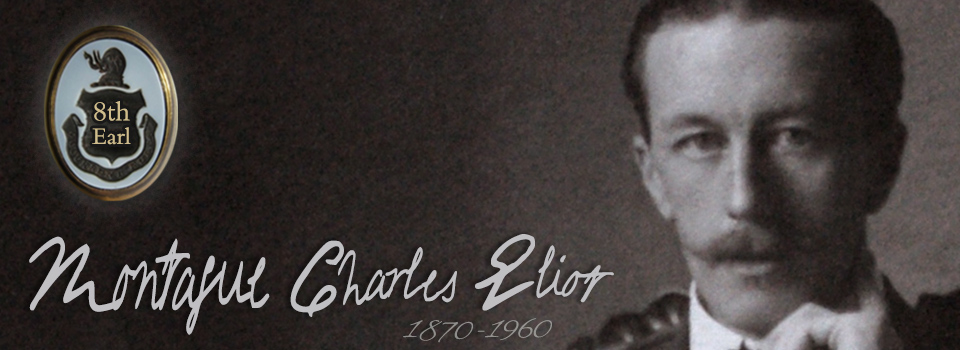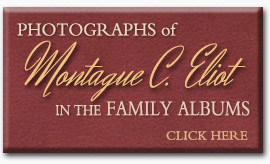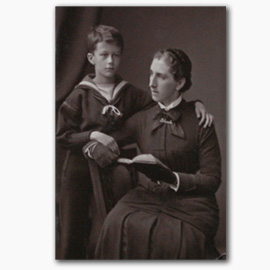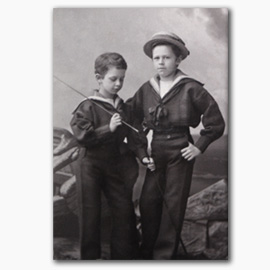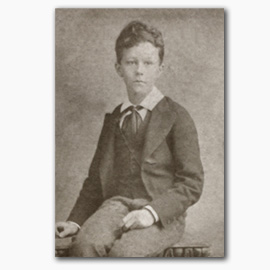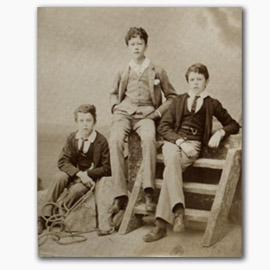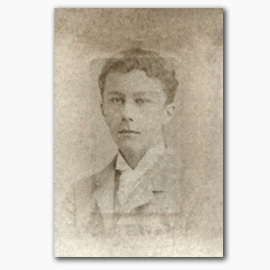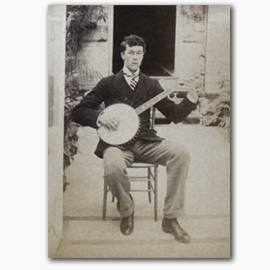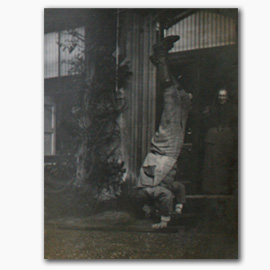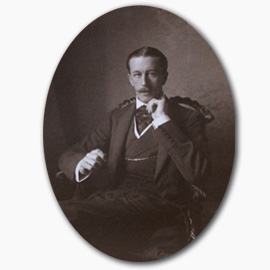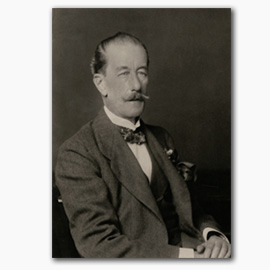Montague Charles Eliot (1870 - 1960)
Monatgue was the fourth child and second son of Charles Eliot and Constance Guest, known to family and friends as Monty.
Monty Eliot is an ongoing "research project", so I haven't finished a full biography for his page here. He suceeded his older brother to the Earldom in 1942, after which time he made his home at Port Eliot. However, it appears that he must have spent the majority of the previous twenty years (during which time his brother was Earl but never actually resided at Port Eliot) living there as well. He owned Ince Castle in Cornwall during this period as well, though exactly when and for how long are still a mystery. If anyone can add information about his time at Port Eliot or Ince Castle during this time, that would be wonderful!
Many photos of Monty survive in the Port Eliot albums, as well as a portrait or two. There are some photos in the right-hand column here, and you can also click on the button to see more photos.
Like his siblings, Monty inherited a musical talent from his mother. While he was not listed in newspaper reports as often as his sisters, he did perform at some family functions and benefits. He played the banjo, clarinet and saxophone.

— The following was written by Peregrine, 10th Earl St. Germans. He was feeling reminiscent about his grandfather, so he wrote the following:
The Honorable Montague Charles Eliot was my grandfather. He was sent to Charterhouse, where among his childhood friends was Baden Powell. He then went up to Oxford, in 1890, where he made a glittering success of himself at Exeter Collage at Oxford. In Athletics, he was a winning miler and long jumper. In his studies, he attained a double first in Classics. In those days, Classics included a fluency in Greek, Latin and Hebrew; whereby, he could create triple acrostics in all three languages. Having came down from Oxford, he went to up the Bar but never practiced.
‘Monty’ Eliot was a witty, immensely clever and popular ‘fellow’; known amongst his contemporaries as "the Big Shot". His accumulated lifetime bag out shooting reached an incredible 260,000 kills. His game books are filled with little drawings of curious or funny incidents of the day’s sport (e.g., people falling into ditches or having their hats blown away in bad weather). He shot with the Prince of Wales [later King Edward VII] a lot, and they became close friends.
My grandfather had a lifelong affair with Am Dram [Amateur Drama] on the stage and also played multiple instruments. I have found programs of late 19th-century Theatricals at Port Eliot with Monty, aged three, playing ‘The cat that sat on the mat.’ He performed and wrote clever charades and review sketches at Oxford, in country houses and at Court. He also staged elaborate gala shows in London theatres, with Royal patronage, for various charities.
In 1899, my grandfather became a member of Queen Victoria’s household, remaining at Court to serve all the Monarchs of the twentieth century. He looked the very essence of a courtier: tall, cadaverous, straight-backed, high and mighty, not to mention immaculately dressed. It was said of him at the time “that he has all the stiffness of a poker with none of its occasional warmth.” His clothes were often outside the curve of current fashion, neither eccentric nor flash, just extremely stylish. He sported many bejewelled shirt studs, fancy cufflinks and curious tie pins (one of which was definitely not suitable for the grandchildren to see and which, I imagine, had been acquired in the Naughty Nineties). I stumbled on these things years after his death in stud boxes and trunks in long-unvisited attics.

— "Sheffield Daily Telegraph" 18 May 1870, page 3:
Eliot.– On the 18th inst., at 2, Ovington-gardens, the Hon. Mrs. Charles Eliot, of a son.
— "Cheltenham Looker-On" 25 Jun 1910, page 7:
The Marriage was celebrated on Wednesday afternoon at St. George's Church, Honver Square, of Mr. Montague Eliot, one of the Grooms in Waiting to the late King Edward, son of the late Colonel the Hon. Charles Eliot and Hon. Mrs. Eliot, and nephew of the Earl of St. Germans, to Miss Helen Agnes Post, daughter of the late Mr. Arthur Post and of Lady Barrymore. The bride arrived at half-past two o'clock, accompanied by Lord Barrymore, who afterwards gave her away, and was met inside the entrance by her bridesmaids and pages. The bridesmaids were the Hon. Dorothy Smith-Barry, her half-sister; Lady Wenteth Ponsonby, cousin of the bridegroom; Miss Coxwell Rogers, Miss Margaret Trefusis, Miss Conellan, and Miss Clare Frewen. The bride was wearing a robe of white satin with train of anitque lace over chiffon. Her old lace veil, lent by Lord Barrymore's sister, Mrs. Oswald of Auchincruive, was worn over a wreath of orange flowers, and her ornaments included an aquamarine pendant set with diamonds, given her by the bridegroom. Her train was carried by two little pages attired in white satin suits, Lord Clonmore, son of the Earl and Countess of Wicklow, and Master Horace Renshaw, son of Mr. and Lady Winifred Renshaw. Her bridesmaids wore white satin dresses with embroidered chiffon tunics and tulle veils over wreaths of silver rose leaves. They carried sheaves of white lilium longiflorum tied with silver ribbon, and wore blue pendants set in diamonds, the gifts of the bridegroom. Viscount Duncannon, M.P. for Cheltenham, discharged the duties of best man. Hundreds of magnificent presents were received; among them a large silver bowl from the Duke and Duchess of Connaught, a tall seilver flower vase from teh Crown Prince and Crown Princess of Sweden. Lady Barrymore's gifts to her daughter included a diamond and ruby necklace, a diamond ring, a gold fitted dressing case, and all the furniture for her new house. From Lord Barrymore there is a grand piano, and the Hon. Mrs. Charles Eliot gives her son a canteen of table silver. The Earl and Countess of Bessborough sent a large silver tea-tray, and Viscount Duncannon, M.P., a large silver-gilt pheasant. There was a large number of guests, the ladies on entering the church being handed bunches of Caroline Testout roses, and the men received carnation buttonholes. Miss Post is the third American girl to be married into our peerage within a fortnight.
— OBE Awarded on 08 Jul 1919.
Lt. Commander Montague C. Eliot, RNVR – For Valuable services on the staff of the Commander-and-Chief, Devonport
— "Western Morning News" 29 Jul 1922, page 5:
Mr. and Mrs. Montague C. Eliot have arrived at Port Eliot for a stay of several weeks.
— "Birmingham Daily Post" 20 Sep 1960, page 18:
EARL OF ST. GERMANS
The Earl of St. Germans died yesterday at Port Eliot, St. Germans, Cornwall, aged 90. He became the 8th earl by the death of his brother in 1942.
Educated at Charterhouse and Oxford, he was called to the Bar in 1895. He was a lieutenant-commander, R.N.V.R. 1914-19, after which he was attached to the Royal Household. He married Helen Agnes Post, daughter of the late Mr. Arthur Post, of New York, in 1910.
— "England & Wales, National Probate Calendar" (1961, S, St, 55):
St. Germans (Eighth Earl of) Montague Charles of Port Eliot St. Germans Cornwall died 19 September 1960. Probate (save and except settled land) London 2 February to Frederic Lyde Caunter solicitor. Effects 24,812l. 7s. 7d. Further Grant 9 March 1961 St. Germans (Eighth Earl of) Montague Charles of Port Eliot St. Germans Cornwall died 19 September 1960. Probate (limited to settled land) London 9 March to Frederic Lyde Caunter and Sir William Gosselin Trower solicitors. Effects 400,000l. Former Grant P.R. 2 February 1961

Monty Eliot's wedding to Nellie Post was one of the big news items of the day, particularly as it was one of three marriages in a two-week period where an American girl married a gentleman of the British Peerage. Another interesting fact is that the wedding took place in London, when the country was still in mourning for the recently departed King Edward VII. This accounts for most of the guests arriving in black or grey and the bridal party wearing silver and grey. The following transcriptions are some very interesting descriptions of the lavish ceremony and celebration.
— "Cheltenham Looker-On" 25 Jun 1910, page 7:
The Marriage was celebrated on Wednesday afternoon at St. George's Church, Honver Square, of Mr. Montague Eliot, one of the Grooms in Waiting to the late King Edward, son of the late Colonel the Hon. Charles Eliot and Hon. Mrs. Eliot, and nephew of the Earl of St. Germans, to Miss Helen Agnes Post, daughter of the late Mr. Arthur Post and of Lady Barrymore. The bride arrived at half-past two o'clock, accompanied by Lord Barrymore, who afterwards gave her away, and was met inside the entrance by her bridesmaids and pages. The bridesmaids were the Hon. Dorothy Smith-Barry, her half-sister; Lady Wenteth Ponsonby, cousin of the bridegroom; Miss Coxwell Rogers, Miss Margaret Trefusis, Miss Conellan, and Miss Clare Frewen. The bride was wearing a robe of white satin with train of anitque lace over chiffon. Her old lace veil, lent by Lord Barrymore's sister, Mrs. Oswald of Auchincruive, was worn over a wreath of orange flowers, and her ornaments included an aquamarine pendant set with diamonds, given her by the bridegroom. Her train was carried by two little pages attired in white satin suits, Lord Clonmore, son of the Earl and Countess of Wicklow, and Master Horace Renshaw, son of Mr. and Lady Winifred Renshaw. Her bridesmaids wore white satin dresses with embroidered chiffon tunics and tulle veils over wreaths of silver rose leaves. They carried sheaves of white lilium longiflorum tied with silver ribbon, and wore blue pendants set in diamonds, the gifts of the bridegroom. Viscount Duncannon, M.P. for Cheltenham, discharged the duties of best man. Hundreds of magnificent presents were received; among them a large silver bowl from the Duke and Duchess of Connaught, a tall seilver flower vase from teh Crown Prince and Crown Princess of Sweden. Lady Barrymore's gifts to her daughter included a diamond and ruby necklace, a diamond ring, a gold fitted dressing case, and all the furniture for her new house. From Lord Barrymore there is a grand piano, and the Hon. Mrs. Charles Eliot gives her son a canteen of table silver. The Earl and Countess of Bessborough sent a large silver tea-tray, and Viscount Duncannon, M.P., a large silver-gilt pheasant. There was a large number of guests, the ladies on entering the church being handed bunches of Caroline Testout roses, and the men received carnation buttonholes. Miss Post is the third American girl to be married into our peerage within a fortnight.
— "Daily Telegraph & Courier" 23 Jun 1910, page 12:
FASHIONABLE WEDDINGS.
MR. MONTAGUE ELIOT AND MISS HELEN POST.
In St. George's Church, Hanover-square, a large congregation assembled for another Anglo-American wedding, the bridegroom, Mr. Montague Eliot, being the second son of the late Colonel the Hon. Charles Eliot and grandson of the third Earl of St. Germans, and the bride the daughter of the late Mr. Arthur Post and of Lady Barrymore, and niece of Mrs. Adair. The central passage, the chancel, and choir stalls were decorated with white Madonna lilies, palms, and maple foliage, while on the altar was a cross of white flowers with clusters of lilies at either side. The choristers, Canon Edgar Sheppard, D.D. (Sub-Dean of the Chapels Royal), who performed the marriage rite, and the Rev. Prebendary Anderson, rector, awaited the entrance of the bride at the west door. She arrived with her stepfather, Lord Barrymore, who afterwards gave her away. Her dress was a simple one, made with a train, and was of softest white satin, the yoke and the sleeves to the elbows being of old lace. The Court train, worn from the shoulders, was of white mousseline de soie, and three times flounced across with lace, while the deep and prettily graduated end of the round train was softest white satin lumineuse. The veil was arranged over a tiara-shaped wreath of orange blossoms, of which a cluster caught the lace at the side of the yoke. There were two pages, Lord Clanmore (son of the Earl and Countess of Wicklow) and Master Tom Renshaw (son of Mr. Arthur and Lady Winifred Renshaw), dressed in white Ottoman silk, the tunics fastened with plain silver buttons. Six bridesmaids attended — Lady Gweneth Ponsonby, the Hon. Dorothy Smith Barry, Miss Margaret Trefusis, Miss Coxwell Rogers, Miss Claire Frewen, and Miss Connollan. Their dresses were of soft white satin made in classical style; their veils of tulle under wreaths of silver bay leaves, and they carried sheaves of white Annunciation lilies. The choristers preceded them up the church singing, "Lead us, Heavenly Father." The bridegroom, with Viscount Duncannon, M.P., his cousin and best man, awaited the bride, and when she joined him the service began. At its conclusion, while the register was being signed, the organist played the prelude to "The Meistersingers," and when the bridal party passed down the church a Wedding March composed for the occasion by Mr. H.S. Goodhart Rendel, Mus. Bac., cousin of Lord Rendel, was played.
As each lady entered she was handed a dress cluster of large pink roses, while each man was given a white carnation button-hole. These decidedly did lend colour and brightness to the large assemblage. Lady Barrymore wore a charming dress of dove-grey voile de soie. A long tunic deeply edged with raised silk embroidery in the same colour fell over the long skirt. A hat of Tegal straw in the same colour was worn, trimmed with grey feathers shaded to palest mauve. Mrs. Adair had a gown of the old-world tone of mauve which is now in fashion again. It was of crepe de Chine, and over it was a long mantle of net the same colour, embroidered with silk. A straw hat, also the same shade, was worn, trimmed with mauve ostrich plumes. The hon. Mrs. Charles Eliot, mother of the bridegroom, had an aluminium grey chiffon velours dress, and a bonnet of grey lace, embroidered with silver and trimmed with aluminium roses. With her sat her sister, the Countess of Bessborough, whose coat and skirt were of grey tussore, embroidered in the same shade; a grey tulle and flowered toque was worn. The Countess of Dartrey was present at the church, little thinking how soon she was to hear of the accident to her plucky sister, Mrs. Henry Hohler, at the Army Pageant, and with her was her daughter, Lady Mary Dawson. The Earl and Countess of St. Germans came together, Lady St. Germans in black net and lace and a jetted toque. Priscilla Countess Annesley was in black, with white plumes in her hat, and wearing a white ostrich feather boa. The American Ambassador was present, and was one of those who signed the register. The Marchioness of Tweeddale wore a coat and skirt of broche ash grey silk having a touche of mauve in it, and patterned with a sprig of black; a black hat was worn, finished with ash grey ostrich plumes. The Marchioness of Dufferin was dressed in lavender-grey silk muslin, embroidered in shaded-grey floss silk, a whit chip hat was worn, on the crown of which was a mass of silk gauze roses in a pale shade of French grey. The Marchioness Camden was in ivory-white, embroidered voile, and wore a black hat. The Dowager Countess of Arran brought Lady Winifred Gore in white with a black hat; Mrs. Ralph Peto was wearing a white muslin dress, embroidered in pale mauve, and over it a loose coat of soft black, and a black straw hat, with shade black and white plumes falling over the crown. The Hon. Mrs. Harry Lawson was in unrelieved black; Lady Eva Wyndham-Quin, with an ash-grey soft silk dress, wore a black hat; Madame de Domingues was all in black. Mrs. George Conrwallis-West was in black, relieved with white; the Hon. Lady Talbot also had her black attire mingled with a little white. The Countess of Wicklow, in grey-silver silk, patterned with black, wore a white chip hat with a wreath of white roses across the top.
After the wedding, Lady Barrymore held a reception at 20, Hill-street, where the wedding presents were greatly admired. The Duke and Duchess of Connaught sent the bride a silver bowl of graceful shape, and inscribed as a wedding gift from their Royal Highnesses, the Crown Prince and Princess of Sweden a Swedish silver vase, Princess Patricia of Connaught an enamelled and jewelled sunshade-handle, and Princess Frederica of Hanover a crystal and silver vase. Lady Barrymore gave her daughter a house fully-equipped and furnished in Wyndham-place, also a diamond and ruby necklace, a gold-fitted dressing case, and a diamond ring. Lord Barrymore gave her a grand piano. The American Ambassador and Mrs. Whitelaw Reid's gift was an old silver tray, with coffee-pot, sugar-basin, and milk-jug. Mrs. Adair's gift was a diamond tiara. Later in the afternoon Mr. and Mrs. Montague Eliot left for France and Holland; the bride's travelling dress and hat were grey.
